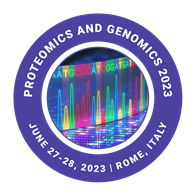About Conference
The organizer of the Global Conference Series invites all participants from all over the world to join the famous scientific “International Summit on Genomics and Proteomics”, which will take place in Rome, Italy on June 27-28, 2023. It is one of the world's most prestigious scientific conferences, hosting scientific sessions and sub-sessions on cutting-edge research and the most recent innovations in the fields of Proteomics and Genomics from all over the world. Attendees will get access to certain unique workshops and panel discussions on the most recent developments in Genomics and Proteomics.
Theme: Current Trends and Innovations in Proteomics, Genomics and Molecular Medicine
Details of Proteomics & Genomics 2023:
|
Conference Name
|
Place
|
Date
|
|
Proteomics and Genomics 2023
|
Rome, Italy
|
June 27-28, 2023
|
Why to attend Proteomics and Genomics 2023?
This is your finest opportunity to access the largest assemblage of participants from universities, colleges, research centers, societies, organizations, labs, groups, communities, and enterprises etc… with members from all over the world focused on Proteomics and Genomics . We wish to organize a global meeting where researchers from various controls may successfully trade data. The purpose of bringing the general public to the meetings is to catalyze empowering trades and connections between professionals in various sectors.
With members from around the world focused on learning about Genomics & Proteomics and its advances; this is your best opportunity to reach the largest assemblage of participants from the Genomics and its allied areas. Conduct presentations, distribute information, meet with current and potential scientists, make a splash with new drug developments, and receive name recognition at this 2-day event. World-renowned speakers, the most recent techniques, developments, and the newest updates in Genomics & Pharmacogenomics are hallmarks of this conference.
Target Audience:
-
Genomic Students
-
Genomics Researchers
-
Genomics Faculty
-
Genomics Scientists
-
Genomics Colleges
-
Pharmacology Scientists
-
Pharmacology Health Professionals
-
Genetics Associations and Societies
-
Geneticists
-
Genetic Counsellors
-
Bio pharmacists
-
Business Entrepreneurs
-
Training Institutes
-
Software developing companies
-
Data Management Companies
Conference opportunities:
For Researchers and Faculty members:
-
Speaker presentations
-
Poster presentation
-
Symposium hosting
-
Workshop organizing
For Universities, Associations & Societies:
-
Association partnering
-
Collaboration proposals
-
Academic partnering
-
Group participation
For students and Research scholars:
-
Poster competition
-
Young Researcher Forum
-
Student attendee
-
Group registrations
For Business Delegates:
-
Speaker presentations
-
Symposium hosting
-
Book launch event
-
Networking opportunities
-
Audience participation
For Product manufacturers:
-
Exhibitor and Vendor booths
-
Sponsorship opportunities
-
Product launch
-
Workshop organization
-
Scientific partnering
-
Marketing and Networking with clients
Advantages of Participating at our Conference
-
The advantages of the Speaker and abstract pages are created in Google on your profile under your name would get worldwide visibility.
-
Our comprehensive online advertising attracts 30000+ users and 50000+ views to our Library of Abstracts, which takes researchers and speakers to our webinar.
-
Meet with hundreds of like-minded experts who are pioneers in Genomics and Proteomics and share ideas.
-
All participants in the webinar would have a different reason to participate with eminent speakers and renowned keynote speakers in one-to-one meetings.
-
A rare opportunity to listen what the world's experts are learning about from the world's most influential researchers in the area of Genomics and Proteomics at our Keynote sessions.
-
Genomics and Proteomics 2023 intensive webinar schedule, you will acquire experience and expertise in strategic gift preparation that is worth its weight golf, forming an impressive array of recognized professionals.
-
Best Poster Award nominations.
-
Award for Outstanding Young Researcher.
-
Group Registration Advantages.
Benefits of Participation for Speaker
-
Worldwide appreciation of the profile of Researchers.
-
Obtain credits for professional growth.
-
Explore the latest of cutting edge analysis.
-
Make long-term bonds at social and networking activities.
-
An ability to advertise one page in the distribution of abstract books and flyers that ultimately gets 1 million views and adds great value to your research profile.
-
Learn a transition beyond your area of interest to learn more about new subjects and studies away from your core subject of Genomics and Proteomics.
-
We have distinctive networking, learning and enjoyable integration into a single package.
Benefits of Participation for Delegate
-
Professional Development-Improve understanding and knowledge.
-
Attendance at webinars supports rejuvenates and energizes delegates.
-
Your involvement in our webinar will help with a new methodology and ideology that can be used to broaden the outcomes of businesses or industries.
-
Opportunities for Genomics and Proteomics researchers and experts in the same field to meet and exchange new ideas through an online webinar.
Benefit of Participation for Sponsor
-
Exposure to the international environment would increase the possibility of new companies.
-
Opportunity to demonstrate your company's latest technologies, new products, or service your business to a wide range of international participants.
-
Increase business by our webinar participants through lead generation.
-
It takes a lot of time, effort and drive to create a successful company, so it's always nice to have a network of colleagues and associates to draw energy from individuals who share a common drive and objective.
-
Webinars in Genomics and Proteomics provide opportunities for more attention and contemplation that could help you move your company to the next stage.
-
Benchmarking main organization plans and moving it forward.
-
Get feedback from trustworthy people at our webinar to your company questions and challenges.
-
On our webinar banner, website and other proceedings, branding and marketing content, the advertising logo of your company.
Benefit of Association for Collaborators
-
Nobody has these massive visitors to Genomics and Proteomics in the world this is the best forum to highlight society.
-
Creating long-lasting peer relationships.
-
In our webinar banner, website and other proceedings, branding and marketing material, promotional content and your Organization logo will increase your number of subscribers/members by 40%.
-
The exposure of our event to your Company listing in the Global Business forum will have a great effect on your association.
-
Your representatives can network to update their knowledge and understanding of your organization and services with key webinar delegates.
-
Genomics and Proteomics advertising materials such as posters, brochures, pamphlets, services that will be circulated to hospitals, universities, society and researchers will be integrated with information.
Genomics and Proteomics 2023 bring together resources and expertise to bridge Genomics & Proteomics to disclose significant global discoveries in Human Health. It provides a great platform to cover recent breakthroughs in Genomics, Molecular Biology, Bioinformatics, Plant Genomics, new genomic tools and its allied areas. The theme of the conference will focus the on translating genomic advances into Human Benefits and to address Envisioning the future and exploring all facets of proteomics and genomics.
For more details please visit: https://genomics.annualcongress.com/
Sessions & Tracks
Track 01: Proteomics and Genomics
Proteomics is a large study of proteome. A proteome is a set of proteins produced in an organism, system, or biological situation. For example, it can represent a proteome of a species (such as Homo sapiens) or an organ (such as the liver). Proteome is not constant. It varies from cell to cell and changes over time. To some degree, the proteome reflects the underlying transcriptome. However, protein activity (often measured by the kinetics of processes involving proteins) is regulated by many factors, in addition to the expression level of the relevant gene.
Genomics is a department of biotechnology concerned with applying the procedures of genetics and atomic science to the hereditary mapping and DNA sequencing of sets of qualities or the total genomes of selected living beings, with organizing the results in databases, and with applications of the information (as in pharmaceutical or science)
Track 02: Biomarkers
Biomarkers can be trademark organic properties or particles that can be recognized and measured in parts of the body such as the blood or tissue. Biomarkers can be specific cells, molecules, or qualities, quality things, chemicals, or hormones. Atomic marker is a segment of DNA that's associated with a particular zone interior of the genome. Nuclear markers are utilized as a portion of sub-atomic science and biotechnology to recognize a particular gathering of DNA in a pool of cloud DNA.
Track 03: Metabolomics and Metabonomics
Metabolomics: Metabolomics is the large-scale study of little particles, commonly known as metabolites, inside cells, bio fluids, tissues or life forms. Collectively, these little atoms and their intuitive inside an organic framework are known as the metabolome.
Just as genomics is the study of DNA and hereditary data inside a cell, and Transcriptomics is the study of RNA and contrasts in mRNA expression; metabolomics is the consider of substrates and products of digestion system, which are affected by both genetic and natural variables.
Metabolomics is an effective approach since metabolites and their concentrations, unlike other “omics” measures, specifically reflect the basic biochemical action and state of cells / tissues. In this way metabolomics best speaks to the atomic phenotype.
Metabonomics: Metabonomics is “the quantitative estimation over time of the metabolic reactions of an individual or population to medicate treatment or other intervention”, such as a illness process, and gives a ‘topâ€down’ integrated overview of the organic chemistry in a complex framework. The metabolic profile is decided by both have hereditary and natural components. As such, Metabonomics has incredible potential for intensive care medication, where patients are complex and understanding the relationship of host factors, illness and treatment impacts is key to making strides care. Approaches that focus on single or little sets of biomarkers may fall flat to capture this complexity, so metabolomics may have preferences for both understanding infections and improving diagnostics and treatment monitoring.
Track 04: Toxicogenomics and Pharmacoproteomics
Toxicogenomics: Toxicogenomics is a field of science that deals with the collection, translation and capacity of data about quality and protein movement inside specific cells or tissues of an organism in reaction to toxic substances. Toxicogenomics combines toxicology with genomics or other tall throughput atomic profiling advances such as Transcriptomics, proteomics and metabolomics. Toxicogenomics endeavors to illustrate atomic components advanced within the expression of harmfulness, and to determine molecular expression designs that anticipate harmfulness or the genetic helplessness to it.
Pharmacoproteomics: Pharmacoproteomics is a quickly progressing field in which the methods of proteomics are connected to develop pharmaceutical specialists. The word itself was coined only in 1997.
However, this branch of study plays a major part in personalized medicine. The word proteomics itself implies the study of proteomes, a proteome being the total complement of proteins expressed by an organism or tissue under specified conditions at an indicated time.
Proteomes are subsequently dynamic, and a given human may have a proteome with as numerous as two million proteins. The use of this full set of proteins to think about the impact of illness or drugs can substitute for much more complex measures in pharmacodynamics at a lower cost in time, financial yield, and clinical risk.
Track 05: Computational Biology, Bioinformatics, and Biostatistics
Computational Biology: Computational biology involves the advancement and application of data-analytical and theoretical strategies, mathematical modeling and computational simulation techniques to the think about of organic, environmental, behavioral, and social frameworks. The field is broadly characterized and incorporates establishments in science, connected arithmetic, measurements, natural chemistry, chemistry, biophysics, atomic science, hereditary qualities, genomics, computer science, biology, and advancement, but is most commonly thought of as the intersection of computer science, biology, and big data.
Bioinformatics: Bioinformatics is an interdisciplinary field that develops methods and program devices for understanding organic information, in specific when the data sets are expansive and complex. As an interdisciplinary field of science, bioinformatics combines science, chemistry, material science, computer science, data building, arithmetic and insights to analyze and translate the biological data. Bioinformatics has been utilized for in silicon analyses of organic queries utilizing mathematical and statistical techniques.
Biostatistics: Biostatistics is also known as biometry is the development and application of measurable strategies to a wide range of subjects in science. It includes the plan of natural tests, the collection and investigation of information from those tests and the translation of the results.
Bio statistical modeling forms an critical portion of various modern biological theories. Genetics studies, since its beginning, used statistical concepts to understand observed exploratory comes about. Some genetics researchers indeed contributed with factual progresses with the improvement of strategies and instruments.
Track 06: Modern Genetics
Genetics could be a department of science concerned with the study of qualities, hereditary variety, and heredity in living beings. In spite of the fact that heredity had been watched for centuries, Gregor Mendel, Moravian researcher and Augustinian minister working within the 19th century in Brno, was the primary to think about hereditary qualities logically. He observed that organisms inherit characteristics by way of discrete "units of legacy". This term, still utilized nowadays, could be a to some degree equivocal definition of what is referred to as a gene.
Track 07: Signaling/Computational Biomedical Data Engineering
Computational Bioengineering generally depicts the science of computational approaches to biological and medical issues ranging from atomic modeling to healthcare informatics including computational biomechanics and computational bio imaging.
Molecular modeling can include organic grouping examination, the structure and work of proteins and nucleic acids, genetic systems and quality expression, atomic advancement, and theory era from large-scale information sources. Computational molecular models can be used to inform judicious medicate plan. Healthcare informatics can be utilized to look at clinical information to superior get it malady movement and treatment.
Computational strategies can also be brought to bear in the understanding of biophysical marvels such as liquid flow in blood vessels, within the mechanics of cartilage compression, and within the preparing of therapeutic images.
Biomedical Information Science includes the investigation of large-scale biomedical datasets to get it how living frameworks work. Our scholarly and investigate programs in Biomedical Data Science center on creating modern information examination advances in arrange to understand illness mechanisms and provide improved health care at lower costs.
Track 08: Transcriptomics
Transcriptomics technologies are the techniques utilized to study an organism's transcriptome, the whole of all of its RNA transcripts. The information content of a living being is recorded within the DNA of its genome and communicated through translation. Here, mRNA serves as a transient mediator particle within the data organize, while non-coding RNAs perform extra assorted capacities. A transcriptome captures a preview in time of the entire transcripts display in a cell. Transcriptomics advances give a wide account of which cellular forms are dynamic and which are torpid. A major challenge in atomic science is to get it how a single genome gives rise to an assortment of cells. Another is how quality expression is controlled.
Track 09: Clinical Genomics & Clinical Proteomics
Clinical Genomics: Clinical genomics deals with the influence of differences in the genome on our health, and pharmacogenomics encourages the improvement of new medications and looks for to form clearer statements concerning the possible adequacy of a certain pharmaceutical in a certain understanding. Single-nucleotide polymorphisms (SNPs, pronounced snips), those little point changes found on average every 1000 to 5000 bases in our genome which are capable for the contrasts between individuals,1 are of extraordinary interest in clinical genomics and pharmacogenomics. They may offer assistance us get it why a few disease influences only certain people or why a medication capacities in only 30% or 50% of the population and causes extreme side effects in another 30%.
Clinical Proteomics: Clinical Proteomics includes all perspectives of translational proteomics. This incorporates quantitative and subjective profiling of proteins and peptides that are present in clinical examples like human tissues and body liquids. Special emphasis is put on the application of proteomic innovation to all viewpoints of clinical investigate and molecular medicine
Track 10: Genome Projects and Genome Sequencing
Genome Projects: Genome projects are scientific endeavors that eventually point to decide the total genome arrangement of a life form (be it an creature, a plant, an organism, a bacterium, an archaean, a protist or a virus) and to explain protein-coding qualities and other vital genome-encoded features. The genome sequence of an organism includes the collective DNA sequences of each chromosome in the organism. For a bacterium containing a single chromosome, a genome project will aim to map the sequence of that chromosome. For the human species, whose genome includes 22 pairs of autosomes and 2 sex chromosomes, a complete genome sequence will involve 46 separate chromosome sequences.
Genome Sequencing: Genome sequencing (GS), also known as full genome sequencing, complete genome sequencing, or entire genome sequencing, is the method of determining the aggregate, or about the aggregate, of the DNA grouping of an organism's genome at a single time. This involves sequencing all of an organism's chromosomal DNA as well as DNA contained in the mitochondria and, for plants, within the chloroplast.
Genome sequencing has largely been utilized as a research tool, but was being introduced to clinics in 2014. In the future of personalized pharmaceutical, entire genome arrangement information may be an important instrument to direct helpful mediation. The instrument of quality sequencing at SNP level is also used to pinpoint functional variations from association studies and improve the knowledge accessible to analysts fascinated by evolutionary science, and thus may lay the establishment for anticipating disease susceptibility and drug response.
Track 11: Computing in Biomedicine and Genomics
Biomedical computing combines the diagnostic and investigative aspects of biology and medical science with the power and problem-solving capabilities of modern computing. Computers are used to accelerate research learning, simulate patient behavior and visualize complex biological models.
Genomics is a department of biotechnology concerned with applying the procedures of genetics and atomic science to the hereditary mapping and DNA sequencing of sets of qualities or the total genomes of selected living beings, with organizing the results in databases, and with applications of the information (as in pharmaceutical or science).
Track 12: E-Health, Telemedicine
E-Health: E-health is also called e-health care, use of digital and communication technologies, such as computers, the Internet, and mobile devices, to facilitate health development and health care services. E-health is often used in conjunction with traditional "offline" (non-digital) methods of delivering targeted information to the patient and the healthcare consumer.
Need for E-Health: E-health grew in the need for improved documentation and patient health monitoring and procedures performed on patients, particularly for recovery purposes, such as insurance companies. Traditionally, healthcare providers kept paper records in the history and status of their patients. However, rising costs of health care and technological advances have encouraged the development of electronic tracking systems. As e-health technology continued to evolve, the field of telemedicine, in which communications technology was used to provide health care remotely, emerged.
E-Health technologies: E-health uses a wide range of digital technologies. The Internet, allows e-health users to communicate with health care professionals via email, access medical records, research health information, and engage in person-to-person exchange of text, audio, video, and other data. Interactive TV, also known as polycom, provides both audio and visual transmission of various information between two or more people in two or more locations in real time.
Track 13: Proteomics Technologies
Proteomics involves the use of technology to identify and quantify the total amount of protein present in a cell, tissue, or organism. Add other "omics" technologies such as genomic and Transcriptomics to explain the protein identity of an organism, as well as to identify the structure and functions of a particular protein. Proteomics-based technologies are used in a variety of ways in different research settings such as the discovery of different diagnostic criteria, people who will develop vaccines, understanding pathogenicity patterns, modification of patterns that respond to different signal signals and interpretation of protein mechanisms that work in various diseases. Proteomics is really complex because it involves the analysis and classification of all genome protein signatures.
Track 14: Cancer Epigenetics
Cancer epigenetics is the study of epigenetic mutations in the DNA of cancer cells that do not involve genetic sequence modification, but rather involves mutations in the way genetic code is expressed. Epigenetic processes are required to maintain normal tissue specific gene expression sequence and are essential for normal development. They may be equally important, or even more important, than the genetic mutation in a cell. Disruption of epigenetic processes in cancer, can lead to a loss of gene expression that occurs about 10 times by documentation rather than mutation.
Track 15: Stem Cell Proteomics
Stem cells receive widespread attention in scientific literature and in society as a whole. This is inspired by their distinctive features - the ability to regenerate themselves and separate multiple lines. Embryonic stem cells (hESCs) have the ability to make all the cells in the adult body once they have received the right signals. The ability to control and regulate in vitro segregation may provide opportunities to improve the treatment of diseases that cannot be cured today, especially in the area of rehab, where the goal is to replace damaged tissue. However, there are still many challenges before hESCs can be used safely in clinical applications. In addition, social and ethical issues need to be addressed before basic science in the area can be successfully translated into clinical practice.
Track 16: Pharmacogenomics
Pharmacogenomics is an important example of an accurate medical field, which aims to integrate the treatment of an individual or a group of people. Pharmacogenomics looks at how your DNA affects the way you react to drugs. In some cases, your DNA can affect whether you respond to a drug or whether the drug helps you or not. Pharmacogenomics can improve your health by helping you to know in advance whether a drug can be beneficial and safe to take.
Drugs interact with your body in many ways, depending on how you take the medicine and where the medicine works in your body. After taking the medicine, your body needs to break it down and take it to its intended place. Your DNA can affect many steps in this process to influence the way you react to a drug. Some examples of this interaction include
Track 17: Protein Interactions in Biology
Decades of research into cell biology, molecular biology, biochemistry, structural biology, and biophysics have produced a remarkable compendium of knowledge on the function and molecular properties of individual proteins. This knowledge is well recorded and manually curated into major protein databases like UniProt. However, proteins rarely act alone. Many times they team up into “molecular machines” and have intricate physicochemical dynamic connections to undertake biological functions at both cellular and systems levels. A critical step towards unraveling the complex molecular relationships in living systems is the mapping of protein-to-protein physical “interactions”. The complete map of protein interactions that can occur in a living organism is called the interactome. Interactome mapping has become one of the main scopes of current biological research, similar to the way “genome” projects were a driving force of molecular biology 20 years ago.
Track 18: Metabolomics in Precision Medicine
The goal of precision medicine is to design disease prevention and clinical care strategies taking into account individual variability in environment, lifestyle, genetics, and molecular phenotype. The application of clinical genomics in cancer to inform selection of therapies and predict outcomes has been the vanguard of the field. Using a microscope as an analogy, genomic tools constitute a powerfully informative objective lens through which to examine individual variability, but it does not provide a view to other biomolecules, such as metabolites, which also define molecular phenotypes. Ideally, a molecular microscope for precision medicine would be equipped with additional objectives to examine biochemistry more broadly. Indeed, measurable changes in metabolite levels occur in response to both complex disease and monogenic disorders, and in contrast to the genome, these changes can exhibit tissue specificity and temporal dynamics. Metabolomics is an emerging field and is broadly defined as the comprehensive measurement of all metabolites and low-molecular-weight molecules in a biological specimen. Because metabolomics affords profiling of much larger numbers of metabolites than are presently covered in standard clinical laboratory techniques, and hence comprehensive coverage of biological processes and metabolic pathways, it holds promise to serve as an essential objective lens in the molecular microscope for precision medicine.
Track 19: Proteomics and its Medicinal Research
Proteomics is a large study of proteome. A proteome is a set of proteins produced in an organism, system, or biological situation. For example, it can represent a proteome of a species (such as Homo sapiens) or an organ (such as the liver). Proteome is not constant. It varies from cell to cell and changes over time. To some degree, the proteome reflects the underlying transcriptome. However, protein activity (often measured by the kinetics of processes involving proteins) is regulated by many factors, in addition to the expression level of the relevant gene.
Proteomics is used to Research:
-
When and where proteins are expressed
-
Rates of protein production, degradation, and steady-state abundance
-
How proteins are modified (for example, post-translational modifications (PTMs) such as phosphorylation)
-
The movement of proteins between subcellular compartments
-
The involvement of proteins in metabolic pathways
-
How proteins interact with one another
Proteomics can provide significant biological information for many biological problems, such as:
-
Which proteins interact with a particular protein of interest (for example, the tumour suppressor protein p53)? (Human example)
-
Which proteins are localised to a subcellular compartment (for example, the mitochondrion)? (Human example)
-
Which proteins are involved in a biological process (for example, circadian rhythm)? (Human example)
Track 20: Cardiovascular Proteomics
The development of proteomics is a timely one for cardiovascular research. Analyses at the organ, subcellular, and molecular levels have revealed dynamic, complex, and subtle intracellular processes associated with heart and vascular disease. The power and flexibility of proteomic analyses, which facilitate protein separation, identification, and characterization, should hasten our understanding of these processes at the protein level. Properly applied, proteomics provides researchers with cellular protein “inventories” at particular moments in time, making it ideal for archiving protein modification due to a specific infection, condition, or treatment.
Track 21: Immunogenetics and Immunology
Immunogenetics: Immunogenetics or immune genetics is the branch of Medical Immunology and Therapeutic Genetics that explores the relationship between the immune system and genetics. Autoimmune illnesses, such as type 1 diabetes, are complex genetic traits which result from defects in the immune framework. Identification of genes characterizing the resistant surrenders may distinguish unused target qualities for therapeutic approaches. Alternatively, genetic varieties can also help to characterize the immunological pathway leading to disease.
Immunology: Immunology is the study of the immune system and is a very important branch of the restorative and organic sciences. The immune system ensures us from disease through different lines of defense. If the immune system isn't working because it should, it can result in illness, such as autoimmunity, sensitivity and cancer. It is additionally now getting to be clear that resistant reactions contribute to the development of numerous common disorders not traditionally viewed as immunologic, counting metabolic, cardiovascular, and neurodegenerative conditions such as Alzheimer’s.












